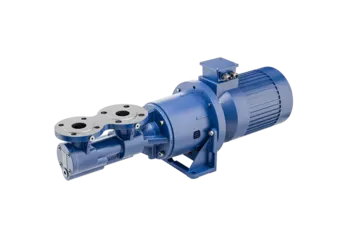Positive displacement pumps
Do you know the advantages of positive displacement pumps, but are still undecided as to which types of positive displacement pumps are best suited to your needs?
In this article you will find an overview and an initial decision-making aid.
Before we go into the different types of positive displacement pumps, here is a brief explanation of how they work:
Positive displacement pumps work, as the name suggests, according to the positive displacement principle. Put simply, a positive displacement pump collects liquid and forces it into the pressure line. This movement is triggered (in the case of screw pumps, for example) by two or three spindles that move in opposite directions and thus displace the liquid.
Closed displacement volumes ("chambers") are formed and the liquid is conveyed under constant pressure. Due to this operating principle, the liquid cannot flow in the opposite direction even when the pump is stationary.
KRAL - Your expert for pump technology.
Convince yourself of our services. We are here for you.

Types of positive displacement pumps and their advantages.
In the case of positive displacement pumps, a basic distinction is made between the oscillating positive displacement pump (piston pump, diaphragm pump) and the rotating variant (gear pump, impeller pump, impeller pump, peristaltic pump, etc.).
The great advantage of all positive displacement pumps - whether rotating or oscillating - is that, unlike other types of pumps (e.g. flow pumps), they allow an almost constant flow rate, regardless of pressure changes, viscosities and temperature fluctuations.
The efficiency of a positive displacement pump can be many times higher than that of other pump types in cases where high differential pressures, high viscosities and strong temperature fluctuations can occur.
The question is therefore often not whether a positive displacement pump is yes or no, but rather which type of positive displacement pump is the best for the particular application given the large selection available.
Gear pumps, for example, have the disadvantage that the bearing is located in the pumped liquid, which makes them sensitive to solids and also deflects the liquid.
Rotary lobe pumps, on the other hand, allow solids but have poor suction characteristics and are also not suitable for high speeds.
Impeller pumps have good suction characteristics, but are less suitable for high viscosities and high differential pressures.
Peristaltic pumps: These are also not suitable for high differential pressures. Only low speeds are possible and the medium is also squeezed. Their service life is also short.
Althoughimpeller pumps are simple in design, they are only suitable for low pressures and their power density is low.
In view of the advantages and disadvantages listed above, the screw pump has proven to be the optimum choice in many cases, which is why KRAL, for example, has specialized in it.
Types of positive displacement pumps and their advantages.
The advantages of the screw pump are obvious. They are quiet, they pump gently (no squeezing of the medium!), have very good suction characteristics, high efficiency and a long service life. They are also generally low-maintenance.
Both the 2-spindle screw pump and the 3-spindle screw pump should be mentioned here.
The advantages of the 3-spindle screw pump in particular are:
- They pump liquids particularly gently and quietly.
- High power density.
- Constant flow rate.
- No pressure pulses that could damage components or cause vibrations.
- Pressure-stiff characteristic curve (the flow rate is hardly reduced when the pressure is increased).
Do you have any questions? - We will be happy to help you!
Please contact us by phone or e-mail or use our inquiry form and we will get back to you shortly.
Conclusion.
As the viscosity of the liquids to be pumped increases, positive displacement pumps are indispensable. They are also necessary when working with different pressures or with large temperature fluctuations. In many applications, the screw pump is a reliable choice in terms of price-performance ratio.

- Oil and gas industry: transporting crude oil, refinery products and chemical processes.
- Chemical industry: transportation of chemicals, acids, alkalis and other aggressive liquids.
- Marine and shipping: Bilge dewatering, fuel supply, ballast water handling.
- Power generation: Feeding fuel into gas turbines, pumping coolants.
- Mining and mineral processing: pumping slurries, abrasive media and dense liquids.
- Agriculture: Irrigation, fertilizer metering, and animal feed production.
Do you have any questions?
Positive displacement pumps
Technical data of our positive displacement pumps








